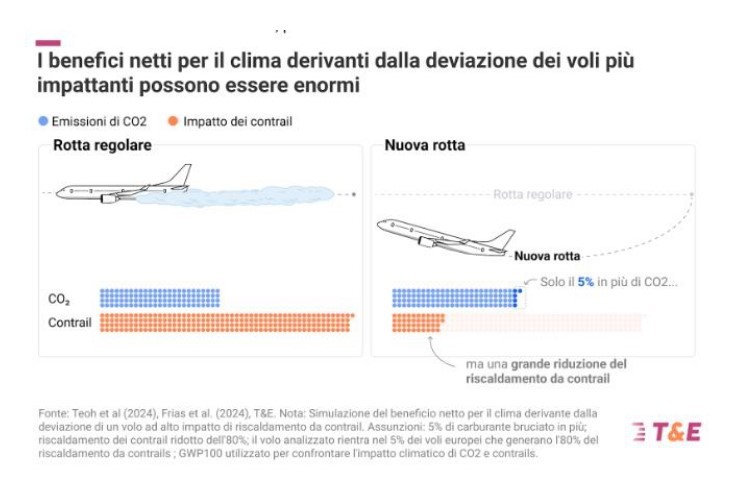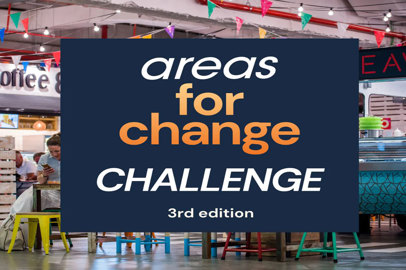21 November 2024
Changing the route of 3% of flights to halve the impact of contrails
Reducing global warming with a simple and cost-effective solution: Transport & Environment's report points the finger at the
Contrails are among the main culprits of aviation-generated global warming, an aspect often ignored compared to CO2 emissions. But a study by Transport & Environment (T&E), a leading European organization in the decarbonization of transport, offers a surprisingly simple solution: slightly change the route of 3% of global flights It could reduce the climate impact of contrails by 50% by 2040.

Photo: © Transport & Environment Press Office (T&E)
Contrails form when planes fly in cold, moist air, leaving thin ice trails in the sky. Although many of these dissolve within minutes, some persist, forming artificial cirrus clouds that trap heat in the atmosphere.
These effects, according to experts, have an impact on global warming that is often greater than that of CO2 historically emitted by aviation.
T&E He proposes a simple strategy: slightly change the route of a small percentage of flights to avoid the conditions that cause contrails to form. This approach, according to the report, would have a minimal cost: an increase of just 0.5% in fuel consumption on a global scale and a cost of about 2 euros per passenger on an intercontinental flight, such as the Rome-Montreal route.
The climate benefits from not forming contrails would be 15 to 40 times greater than the impact of the additional CO2 emissions generated by the change of course.
The proposed changes would have an immediate effect. Carlo Tritto, Sustainable Fuels Manager at T&E Italia, points out:
"The aviation industry has a simple and cost-effective way to reduce its impact on the climate. It is no longer a question of discussing whether to do it, but of deciding how and how quickly to act."
"The aviation industry has a simple and cost-effective way to reduce its impact on the climate. It is no longer a question of discussing whether to do it, but of deciding how and how quickly to act."

Graphic: © Transport & Environment (T&E) Press Office
Not all contrails are created equal. The study shows that latitude, time and seasonality play a key role in theclimate impact of contrails.
Flights that cross North America, Europe and the North Atlantic are among the most damaging, as are those that take off in winter or during the evening and night hours.
Thanks to increasingly advanced technological tools, such as humidity sensors and satellites, it is now possible to identify the most risky routes in real time and prevent their effects.
Transport & Environment proposes three main steps to address the problem:
- Monitor contrails with advanced tools to identify the most critical flights.
- Prevent the formation of contrails through regulations and guidelines for airlines and air traffic control authorities.
- Incentivize the adoption of innovative technologies, supporting the costs of development and implementation.
T&E recommends that by 2027 the EU introduce a mandatory contract monitoring system for all flights and launch financing programmes for airlines and aircraft manufacturers.
Avoiding the formation of contrails is one of the most accessible and low-cost climate solutions available for the aviation industry today. With costs of around €20 per tonne of CO2 equivalent avoided, this strategy is over 15 times cheaper than other options, such as carbon capture and storage.
Contrails are not the definitive solution to the problem of aviation emissions, but they represent a first, important step towards a more sustainable future for the aviation sector.
Transport & Environment (T&E)
It is the leading independent European organisation dedicated to the promotion of sustainable transport and energy policies. Founded over 30 years ago, T&E has helped shape some of the most significant environmental laws in Europe. Its mission is to promote a zero-emission mobility system that is accessible and has minimal impact on health, climate and the environment.
The organisation works with around 50 organisations across Europe, mainly environmental groups and activists committed to sustainable transport policies at national, regional and local levels.By the editorial staff of Avion Tourism Magazine
Text source and photo: © Transport & Environment Press Office (T&E)
Partnership with Booking.com
Hotel
You might be interested in
Sustainability

Environmental Sustainability
Brussels Airport supports sustainable projects
Funding for environmental and social initiatives in the local community and the area surrounding the airport to support the environment, energy, mobility and nature
Sustainability

Environmental Sustainability
Ita Airways reduces food waste for environmental sustainability
Airline launches Meal Donation and excess food on board flights is returned to communities in need
Sustainability

Environmental Sustainability
3rd edition of "Areas for Change Challenge"
A global initiative to engage innovative startups in the development of sustainable solutions in the Food & Beverage and travel retail sectors



